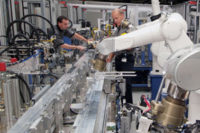Algorithm Optimizes Collaboration Between Robots, People on Assembly Lines

A new computer algorithm could help engineers optimize cost and efficiency when employing multiple robots alongside people on assembly lines.
Developed by researchers at Wuhan University of Science and Technology in China and the University of Leicester in the U.K., the software is based on a metaheuristic algorithm known as the “migrating bird optimization algorithm,” which is often used for solving optimization problems due to its simplicity and flexibility.
The goal of the software is to optimize assembly lines in which robots and people collaborate, ensuring that both can work effectively and safely. To do this, the researchers developed a multi-objective, mixed-integer programming model. They then tested it on several scenarios in which different types of robots are expected to work together to assemble goods.
The algorithm’s design is inspired by the V-shaped flight formation of migrating geese. Given a set of possibilities, the algorithm picks a solution that optimizes total cost and reduces overall cycle time.
“For many industries, purchasing robots will be an expensive affair,” says Mukund Janardhanan, Ph.D., a professor of engineering management at the University of Leicester. “[Our model] will help production managers to estimate and optimize [cost and cycle time] simultaneously.”
In the future, the researchers intend to incorporate other objectives, such as energy consumption optimization, into the algorithm.
Looking for a reprint of this article?
From high-res PDFs to custom plaques, order your copy today!








